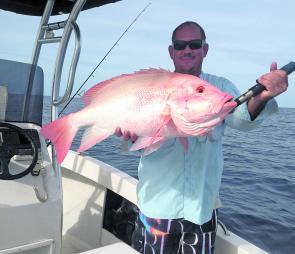The Far North has had as a normal and healthy wet season leading into March. There have been good rains distributed across the top end which began from around mid-January and have been consistent since. There’s been tropical lows and a few cyclones to keep an eye on but you expect that for a normal wet season. We can expect much the same for the coming month.
Fishing-wise we’ve had some interesting moments both inshore and offshore. On the outer reef the bottom fishing has produced fewer fish but the quality has certainly made up for this deficiency. Reef fishing can be a challenge in the wetter months but there have been some impressive fish caught in between the slower periods, which have been generally associated with adverse weather. Thumping red emperor, big large-mouth nannygai (saddletail snapper), solid reef mangrove jack and feisty black cobia have all lit up the stage at certain times. When a powerhouse fish comes over the side all those quiet hours spent on the water just fade into the distance!
Besides these XXL fish there have been some handy coral trout and bar-cheek trout to be found at times, and there have also been runs on spangled emperor. Sweetlip, moses perch and stripies are typically a common occurrence.
The Spanish mackerel have been very sparse on the float and this has also translated to trolling efforts using hardbody diving lures and woghead garfish rigs. Surprisingly though, the occasional small black marlin up to 150lb has been hooked while trolling the light tackle gear well inside the outer edge reef. The blacks have been present where the small skipjack tuna have been working the surface.
Closer to the coastline, the wonky holes have fired up at times, producing quality large-mouth nannygai, gold-spot cod and cruising cobia. Wonky holes are outflow points of ancient underground river systems, which derive their water from the mountainous coastline and begin to flow out at sea with freshwater when we receive good doses of rain. A lot of the wonky holes occur between the mainland and the start of the outer reef, with the odd hole out even further.
On the sounder the holes resemble an inverted bommie or a vacant V shape below the floor level, and they usually attract all forms of bait life. In real life they look like a rounded mud castle wall with a crater in the middle. The water around these holes is very murky, which is ideal for ambush predators. Prawn trawlers are very well aware of the wonky holes and avoid them like the plague as the craters can catch their nets and cause all sorts of dramas. The local fishermen highly guard their wonky hole locations because they tend to produce only a few fish at a time – but these few fish always seem to be on the monster size scale.
Since the rains, our coastal mangroves and beaches have been inundated with new baitfish and prawn life. This, in turn, has attracted the predators. It’s been a calling card for barra, blue salmon, trevally, queenfish, tarpon, small jewfish and grunter, all of which have been registered by anglers across the region. All these fish have caught using a variety of methods including live baits, soft plastics and imitation prawn lures.
There’s also the chance to cast net a feed of prawns along the way. You’ll never taste better eating prawns that are caught fresh off the beach. Drag nets are still used by some but this is increasingly frowned upon by most anglers due to the bycatch of juvenile fish which are often killed in the process, including tiny barra and blue salmon.
Venturing inland via our rivers, creeks and estuaries, the standout fish during the wetter periods has been the mangrove jack. Jacks seem to revel in these conditions. Other fish may opt to take cover but the mangrove jack has simply excelled.
There’s been no rocket science to catching them either, with the old pilchard lightly weighted doing the deal. The key has been fishing with good run in the tide, whether it’s coming in or out, and sourcing pressure points along the edges which hold plenty of mangrove cover. Quite often there’ll be a mob of them all lined up and all aggressive in nature. Concentration is paramount because these fish hit without notice and will be back under a snag in a heartbeat. It’s a matter of lock up and load when they strike.
When the rains have eased and there’s a bit of normality in the water clarity, the barra will come out to play. Mixed in with them you’ll often find schools of mid-sized GTs, tarpon and small queenfish, and there’s always a bream or a gold-spot cod to catch.
There’s still the odd massive king tide in early March around the new moon, and the fishing will be difficult around the rivers and creeks. Following this, things should settle down provided we don’t get too much rain.
I’m cautiously predicting much the same overall for March (which is notoriously difficult to predict). When the conditions are settled that’s your opportunity to hook into some action.
Reads: 1703
Port Douglas Sportfishing has been registering well on the wonky holes.




